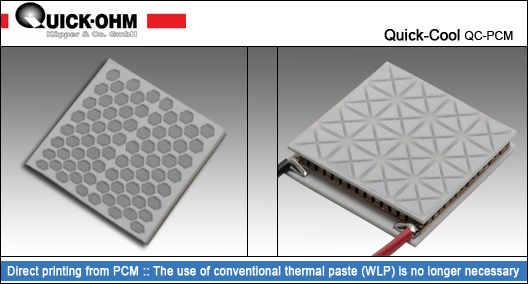|
|
|
QC-PCM is an innovative TIM (Thermal Interface Material) with phase change properties.It is particularly suitable for the thermal connection of electronic components to heat sinks or other cooling surfaces in series production as a replacement for a manually applied thermal compound. Above the phase change temperature, the printed and dried thermal paste spreads even under low pressure and completely wets the surface.
An extremely thin layer thickness is achieved which, together with the excellent thermal conductivity, leads to a low thermal resistance. Surface roughness and slight unevenness are compensated, air pockets are expelled. At no time does the TIM leak or pump out. The parts printed with the QC-PCM are very easy to process in automated processes or by pick-and-place robots. |
|
|

If you have any questions, call us: 0202 40 43 22
Or use our contact form
|
| Applications: |
Thermal connection of:
- Thermally conductive washers, heat sinks
- IGBTs or MOSFETs
- Processors
- Components in electronics / microelectronics in series production
|
| Assembly material/TIM |
Due to the diversity of application areas, it is necessary to design the thermal management precisely to the framework conditions of the project. The correct and safe assembly of the individual components plays a key role here. The use of assembly aids ensures optimum hold and effective heat transfer. In addition, thermal interface material or thermal interface material (TIM) is an important factor in the implementation of the planning. This is usually a paste on a ceramic basis, which is mixed with microscopic particles of aluminum oxide, boron nitride and zinc oxide. Free of silicone and by adding several special synthetic oils, long-term stability is achieved and above-average performance is guaranteed.
The viscosity of the TIM decreases during commissioning. This fills out the smallest surface roughness and displaces harmful air pockets. The paste solidifies in the first 20-30 hours of operation and thus prevents expansion due to temperature fluctuations. With a temperature range of -40 degrees Celsius to 180 degrees Celsius, thermal grease is suitable for a large number of application areas. It also isolates electrical current and is electrically non-capacitive.
Thermal paste is used wherever efficient heat transfer between two objects is to be achieved. For example, between a microchip and a heat sink.
|
| Printing process |
The screen printing process is recommended for applications where conventional thermal paste cannot be used or where mass production of components is necessary. This enables a phase change material (PCM) to be applied directly to individual elements. This material is dry and malleable at room temperature. The PCM has the property of only changing the phase and becoming fluid when installed at a pressure of 30N / cm² and around 45 degrees Celsius. It optimally fills cavities and gaps, thereby ensuring the best heat transfer. This eliminates the need for conventional thermal paste (WLP).
|

|
| Ceramic / thermal washers |
Due to their low-induction properties, ceramic heat-conducting washers primarily serve as an insulator between the Peltier element and sensitive components. They enable galvanic separation and at the same time offer excellent thermal conductivity with resistance to corrosion and wear. In addition, aluminum oxide ceramic is pressure-resistant up to 4,000 MPa and stable up to an operating temperature of 1,000 to 1,500 degrees Celsius. Insulating panes made of glass fiber reinforced silicone are also self-adhesive, flame-retardant and can be used without thermal paste. They offer excellent thermal conductivity and adapt flexibly.
With a selection of various other materials such as polyimide or carbon (optionally self-adhesive), we are able to offer the right solution for every application.
|
|
Technical specifications: Download
|
|
|
| Material: |
printed phase change material |
| Colour: |
Gray |
| Density: |
2,0g/cm3 |
| RoHS compliance:: |
yes, 2011/65/EU |
| Thermal conductivity: |
3,4 W/mK |
| Thermal resistance at 1MPa: |
0,002 °C cm2/W |
| Thermal resistance at 1MPa: |
0,0039 °C cm2/W |
| Thermal resistance at 70kPa: |
0,2 °C cm2/W |
| Phase change temperature: |
45°C |
| Shelf life in the printed state: |
Unlimited in a dust-free environment |
| Maximum application temperature: |
125°C |
| |
|
| Characteristics: Download |
- Very good replacement for conventional WLP
- Extremely thin layer due to defined printing
- Thermal conductivity 3.4W / mK
- Silicone free
- Freely selectable print patterns
- Maximum reproducibility, no manual order
- Clean workplaces, dry printing
|
| |
|